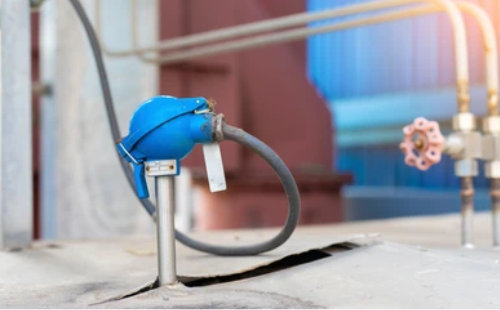
 Troubleshooting tips for resistance temperature sensor
Troubleshooting tips for resistance temperature sensor| Thermal resistance problem | Possible causes | Remedies |
|---|---|---|
| The temperature indication is generally too high | The lead resistance is too high; Not compensated | If possible: (1) Install the larger cable. (2) Compensating lead (3) Use sensor head transmitter (4) Convert to 3-wire or 4-wire circuit (5) Reduce the length of connecting leads |
| Self heating caused by too high measuring current | Use smaller measuring current (1mA current is recommended) | |
| Temperature indication varies with ambient temperature | RTD temperature sensor in 2-wire circuit; The connecting leads are subject to large temperature changes. | circuit; The connecting leads are subject to large temperature changes. (1) Convert to 3-wire circuit, which will basically eliminate the impact of ambient temperature (2) Convert to 4-wire circuit - in this case, the effect of connecting lead resistance is completely eliminated. |
| The temperature indication error increases with the increase of temperature (the indication is too low) | Reduce the insulation resistance as a shunt path for the measurement signal | (1) The insulation resistance of about 0.1M Ω in parallel with 100 Ω will produce an error of the same order of magnitude as the tolerance class B RTD sensor. According to IEC60751, the minimum recommended insulation resistance is: (a) The insulation resistance at 20 ° C (68 ° F) must be greater than or equal to 100M Ω (b) The insulation resistance at 500 ° C (930 ° F) must be greater than or equal to 2 M Ω (2) Replace the defective RTD sensor |
| Deviation of temperature indication from the value in the table (parasitic and current EMF) | (1) The lead material is poor, polluted and wet, (2) Temperature difference between connecting lead terminals. (3) The terminal in the terminal block is corroded. | (1) Check installation (2) Insulate terminals (to the same temperature) |
| Indication changes over time | Thermal aging (drift of measuring resistance) | (1) Select appropriate high-temperature design (2) Periodic recalibration (3) Replace the sensor as necessary. |
Insulation resistance of RTD temperature sensor:
This is the current leakage resistance across and above the insulating material surface of the sensor wire. High insulation resistance means that the sensor is in good condition, while low insulation resistance means that the RTD temperature sensor has some problems that may cause current leakage. Generally, the change of insulation resistance of RTD temperature sensor over time will lead to parasitic short circuit, which acts as a resistor in parallel with the actual RTD temperature sensor resistance. The resulting shunt current will result in a lower false measurement signal. The higher the nominal resistance of RTD temperature sensor sensor, the greater the influence of insulation resistance difference. For example, Pt1000 Ω sensor can feel the influence of insulation resistance difference more than Pt100 Ω sensor.
Test RTD temperature sensor
Two common tests are usually performed on RTD temperature sensors. They are:
(a) Usually, a multimeter is used for continuity test
(b) Use insulation tester for insulation resistance test, such as 60 – 100V
If the following conditions are met, the Pt100 Ω RTD sensor is said to be in good condition:
(a) The resistance value given by the continuity test is about 110 Ω
(b) The insulation test gives an insulation resistance of 100M Ω or more
All tests of RTD temperature sensors are carried out at room temperature.

